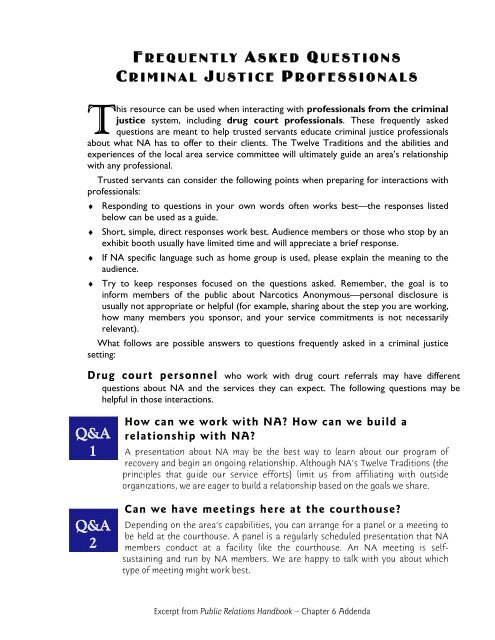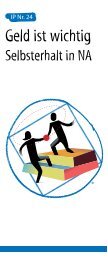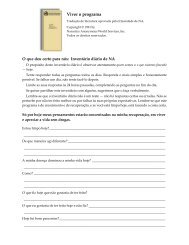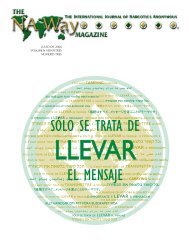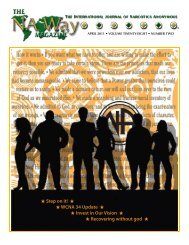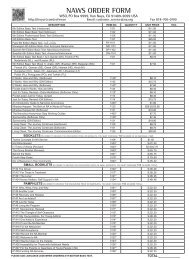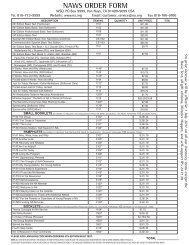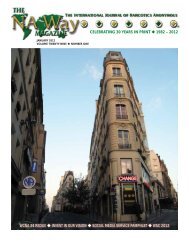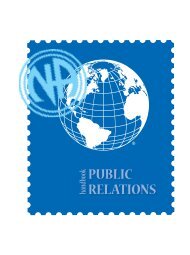Handout-Chapter 6 PRHB Addenda-Boston WWW-2009.pdf
Handout-Chapter 6 PRHB Addenda-Boston WWW-2009.pdf
Handout-Chapter 6 PRHB Addenda-Boston WWW-2009.pdf
You also want an ePaper? Increase the reach of your titles
YUMPU automatically turns print PDFs into web optimized ePapers that Google loves.
Q&A3Does NA sign court cards?Many NA meetings sign court cards. This is a choice made by the members of thatparticular home group, or the area as a whole. If a meeting has made a decision notto sign court cards, this is usually listed in the local meeting directory. You canencourage your clients to check with an NA member before the meeting to be surethe group signs court cards.Q&A4Q&A5For those groups that do sign court cards, will youguarantee that my parolees/probationers will be attendingthe meeting, and will be staying through the entiremeeting?Attendance at our meetings is free and voluntary. We cannot guarantee that anyperson will attend a meeting or remain for its entirety. NA maintains no attendancerecords. We are a program for addicts who want to recover.Can sponsors and/or other NA members testify in court toverify the work that my clients are doing?As indicated in NA’s informational pamphlet, Sponsorship,— a more experienced member helping anewer member. Attending court on behalf of a “sponsee” would be an individualdecision on the part of a sponsor (or any NA member). NA’s traditions (theprinciples that guide our services) speak to maintaining personal anonymity,neutrality, and having no opinion on outside issues.Q&A6Can I read my clients’ step work, and will the sponsorverify that my clients are doing the work that they saythey are doing?Because NA is not affiliated with the courts and because our primary purpose is tohelp others lead drug-free lives, we would not verify step work with the court.Verifying or sharing step work in that way has the potential to jeopardize the trustthat is essential to the sponsorship relationship. However, a client may choose toshare their step work with you, and that decision is entirely theirs.Understanding the criminal justice system and the people who work within that systemcan only help to build strong, long-lasting relationships. Criminal justice professionals have avariety of relationships with treatment centers and recovery homes that may or may notbe different from the type of relationship they can have with NA. It is up to us to clearlycommunicate the kind of relationships we can have, given our primary purpose andtraditions. This kind of communication can only help to build strong relationships and offsetany possible misunderstandings.Excerpt from Public Relations Handbook – <strong>Chapter</strong> 6 <strong>Addenda</strong>
W ELCOMING N EW M EMBERSN EWCOMER W ORKSHOPSOGroup members may have found that, in spite of their best efforts, these newer members’needs are not being met and, with NA’s primary purpose in mind, the group has decided tocreate a plan that will help these new (and potential) members to feel welcome. This plan mayinclude creating a structured format for newcomers. If that is the direction of an area, here arevarious formats that may be considered: Create weekly newcomer meetings. These meetings would function like any NAmeeting; however, they would be identified in the meeting schedule as a “newcomermeeting.” The focus of the meeting would be geared to helping new members understandthe NA program. The meeting format may contain information that provides meeting basicsand etiquette for newer members, such as keytags being given to group memberscelebrating lengths of cleantime, cakes being served at a particular meeting to celebrateannual recovery dates, donation basket being passed with everyone encouraged tocontribute, etc. Some communities use the IPs or Basic Text as a focus for the meeting. Create an ongoing, regularly scheduled workshop (e.g., once a month) geared tothe needs of newer members. The workshop could be in a panel format. Trusted servantsfrom the area may accept the commitment for a year, or panel members may be trustedservants of an area subcommittee. These panels provide a forum for new members to askfor information about NA and our language (e.g., What does “clean” mean? Why do youpass a basket? etc.), and to share information about the NA program such as meetingattendance and the concept of sponsorship. These workshops could be held in a meetingfacility prior to a regularly scheduled NA meeting, at a treatment center that has clientscompleting treatment, or perhaps at a courthouse that has a drug court program. Add a brief new member orientation before the start of regularly scheduledmeetings. This would become part of a meeting format and may address: when attendance slips will be signed, overview of meeting format, purpose of keytags, and purpose of the basket that is passed.This is not an exhaustive list, and your area may want to include additional items for thebrief orientation.We highlighted three ways to help new members feel welcome in a meeting environment,yet there could be any combination of avenues to help with an influx of members.Excerpt from Public Relations Handbook – <strong>Chapter</strong> 6 <strong>Addenda</strong>


